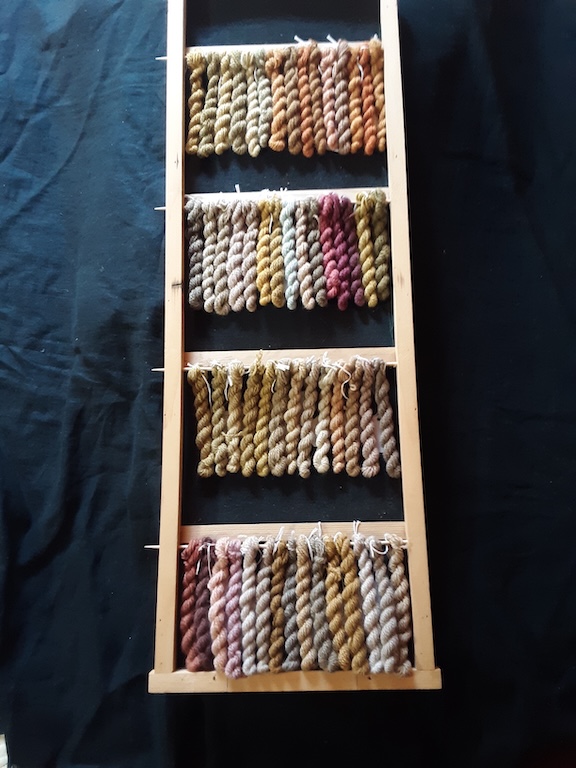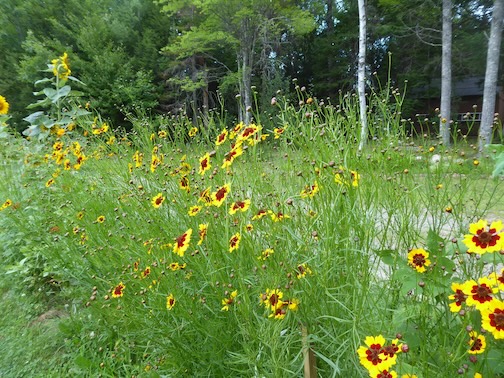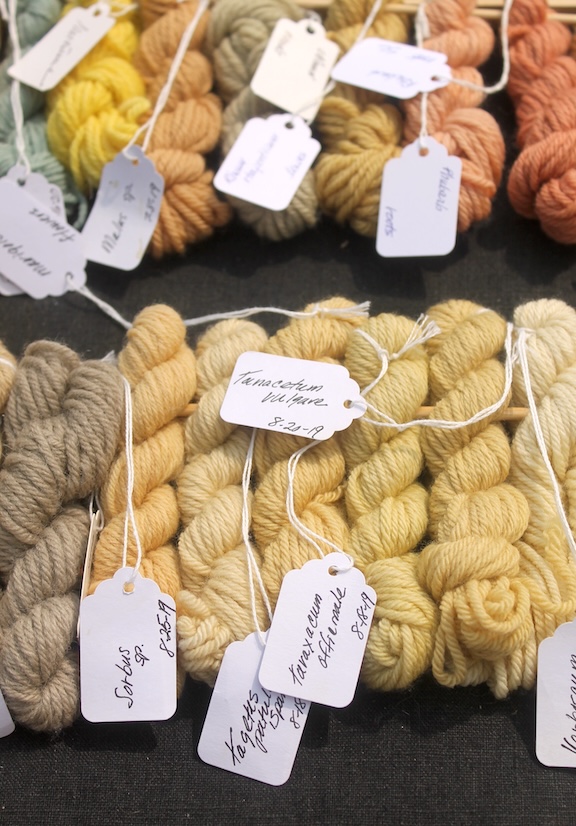After retiring and moving home to Maine in 2019, I embarked on a project in natural dyeing: Dyeing Maine Fibers with Maine Plants. I had begun my exploration of natural dyeing in the 1970s when I had a small flock of sheep in New York’s Hudson Valley and continued to learn while living in California and Connecticut. Recording my results and teaching the basics to others has been especially enjoyable.

No one knows when humans discovered that they could change the appearance of many materials by using colors at hand. Once assured of food, clothing, and shelter, we humans have a need to make something new, beyond the merely practical, whether painting cave walls, tattooing our skin, carving figures, or dyeing leather and fibers.
While some of these artistic creations have been lost to time, some tantalizing artifacts have been found in the world’s deserts, including 6,000-year-old pieces of woven and dyed fabrics in Central Asia, Egypt, and the high deserts of South America. Modern scientific instruments can identify the fibers and dyes used while textile experts can recreate the techniques of our ancestors. In cooler, wetter temperate climates, ancient textiles don’t survive, but some processes have been passed down through millennia. Even as writing developed, people didn’t record their processes because, like carving a wooden spoon or cooking a stew, it didn’t seem necessary. Dyeing, like other arts, may have been kept secret by its few practitioners to protect their status in the community.
The sources for natural dyes include minerals, mollusks, lichens, and fungi, but plant materials are generally the easiest to obtain and use. The plant parts that provide dyes include roots, bark, wood, stems, seeds, leaves, and flowers. In some cases, several parts of the same plant can be used, perhaps for different shades; for others, only one part gives color. There are several types of plant-derived dyestuffs. “Substantive” dyes don’t require special treatment to color natural fibers and are often the same materials that are used to tan hides. “Adjective” dyes require additional chemicals (mordants) to fix the color permanently. “Vat” dyes, like indigo, aren’t soluble in water and require more complex handling, such as fermentation. “Fugitive” colors, like beets, will color Easter eggs, but fade with time, light, or washing and are not recommended for fiber dyeing.

Using plants, a dyer can produce a rainbow plus grays, browns, and blacks, but yellow dyes are the most common. I grow weld (Reseda luteola), dyer’s chamomile (Anthemis tinctoria), dyer’s coreopsis (Coreopsis tinctoria), yellow cosmos (Cosmos sulphureus), and marigolds (Tagetes sp.) in my Central Maine dye garden. Among other good yellow dye plants are goldenrod, narcissus, dandelion, and yarrow. Almost any flower, even red, blue, and white, will give a yellow dye of varying quality.

For red, I grow madder (Rubia tinctoria) — the best red among plant dyes. The very best red dyes are from several species of sub-tropical insects. Madder is a tender, small woody shrub that requires patience as the dye is in the roots, which are harvested after three years or so. If you can find Galium tinctorium, the roots will also give red but require a larger quantity. It’s a New England native, but I have yet to find it on the edge of the swamp where it “should” grow. The bedstraw that persists in my vegetable garden is not the right species, but my ducks like the taste.
I grow Japanese indigo (Persicaria tinctoria), which is more tolerant of our cool climate than other plants containing indigo. By starting it indoors and perhaps growing it in a greenhouse or tunnel you may be able to collect mature seeds. Otherwise, you will need to purchase seeds yearly as they don’t have the longer viability of some plants. The other blue for our area is woad (Isatis tinctoria),which contains one of the many forms of indigo at a much lower concentration. It can be invasive in croplands, but it is not on Maine’s list of invasive species. This is a reminder that conscientious dyers, like other gardeners, don’t share seeds without knowing their deleterious potential.
After growing, foraging, or purchasing dyestuffs, you will need to decide on the fiber to dye. Only natural fibers, or those of predominantly natural sources will accept natural dyes. I love dyeing with locally produced wool, alpaca, angora, and mohair. These “protein” fibers and others from animals will take up natural dyes most easily. Plant or “cellulose” fibers, like linen or hemp, will result in paler shades. Whether unspun fibers, yarn, or fabric, the fiber will need to be “scoured,” the dyer’s term for a gentle but thorough washing to remove excess lanolin as well as dirt, or any oils applied during factory processing.
Almost all fibers will need a mordant to permanently bind the color to the fiber. Mordants are chemical salts and include compounds of aluminum, iron, tin, and copper. The most used among home-scale natural dyers are several types of aluminum, often labeled “alum.” Some are better for cellulose fibers, which also tend to require more steps in processing.
Equipment for dyeing starts with simple cooking pots large enough to allow the fiber to float freely for even results; weighing and measuring tools; and, for most dyes, a source of heat. Pots should be a “non-reactive” material, such as stainless steel or enamel, to avoid unwanted changes in the color or feel of the finished fiber. Do not use dyepots for food. As with many subjects today, the internet has a lot of “information” that is not always trustworthy. Some older books deal with risky mordants that should be used with caution. Two reliable sources of instructions are botanicalcolors.com’s “Learn” pages and the 1999 book “Wild Color: The Complete Guide to Making and Using Natural Dyes” by Jenny Dean, available used or via interlibrary loan.
Natural Dyeing with Onion Skins
Every dyer has their favorite methods. Here are two of my favorite ways of dyeing with onion skins, one of the few dyes that will give long-lasting colors, ranging from yellows to deep golds, without a mordant. The process is less fussy and, as onions are edible, a special dyepot is not needed.
Dyepot Method
Weigh the dry, scoured fiber (protein fibers work best) and wet it thoroughly by soaking it two hours or longer. Weigh out onion skins (yellow, red, or a mix) equal to half the amount of the fiber and simmer the skins in enough water to cover for 30 minutes or longer.
Strain out the onion skins, reserving the liquid dyebath in a large pot. Allow it to cool. Add the wet fiber plus more water as needed to allow the fiber to float freely. Heat to a simmer, stirring gently occasionally so that the fiber will take up the color without tangling. Continue to simmer until the fiber reaches a satisfactory color. It will be lighter when dry. Let the fiber cool in the pot overnight.
Hang the dyed fiber over the pot to dry slowly in a shaded spot. A day or two later rinse the fiber until the water runs clear. Hang to dry again. Once dry, the fiber can be used but avoid washing with soap or detergent for at least a week.
Summer Solar Dyeing
Weigh a small amount of scoured fiber that will easily fit in a gallon jar. Then wet the fiber thoroughly as above. Weigh out half that amount, or more, of onion skins and steep them in the jug for a day or so, just like making sun tea. Strain out the onion skin and add the fiber to the colored water. Place in the sun for a day or so until the fiber reaches a shade you like or the water in the jug has given up its color. Dry, rinse, and dry the fiber again as above.
Checking Lightfastness
You can check the lightfastness of the dyed fiber. Attach a small amount to a card and cover half to keep the light out. Put the sample in a south- or west-facing window for three weeks. When you remove the cover, you can compare the half of the fiber that was exposed to the sun to that which was protected. The change in shade will depend on many variables: the fiber itself; how well it was scoured; the amount of onion skins (their age, type, color); the heat; the length of time heating, and the drying and rinsing processes. You can see that it is almost impossible to achieve the exact color when you do this again. This is frustrating for some people but part of the fun for many dyers who enjoy being surprised.
Jude Hsiang gardens, dyes, knits, weaves, and sews in South China, Maine. Her business, Versicolor, offers workshops and naturally dyed products.
This article was originally published in the summer 2025 issue of The Maine Organic Farmer & Gardener.